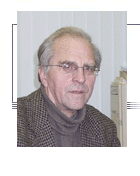


 |
|
|
 Prof. Boris Grishanin |
Boris A. Grishanin is an Associate Professor in the
Department of Physics, M.V.Lomonosov Moscow State University (MSU).
He received his M.S. and Ph.D. degrees from MSU in 1963 and 1968, respectively
(both in Physics). Since 1963 till 1965 he worked in a technical institution
on theoretical problems of radio location. From 1965 till now B. A.
Grishanin is with Moscow State University. He held first a position
of Research Associate (1968), then Assistant Professor (1968-1981),
Senior Researcher (1981-1995) and, finally, a position of Associate
Professor in the Department of Physics and International Laser Center.
Key Scientific Results Information theory. A concept of information value was extended to the systems with a noisy input information and the problems of the Games Theory. Several basic problems of Information Value theory and the problem of optimal quantization of continuous-valued random variables were solved. Theory of adaptation. Analysis of a quality of the adaptation
algorithms based on empiric Bayes approach was performed. Quantum theory of open systems. Effective mathematical technique to represent dynamical superoperators of quantum systems, which makes possible to take into account the dependence of relaxation processes on external fields, was developed in terms of the unique formalism combining symbolic and matrix representations. For two-level quantum systems the most general expression for the markovian relaxation superoperator was derived. For standard experimental conditions the atom dynamics was shown to be ever markovian and the interpretation of the laser-field induced relaxation redistribution as a manifestation of non-markovian dynamics had been inadequate. An effect of population inversion of a two-level atom by monochromatic field was predicted, having been later confirmed experimentally, though evidently seemed impossible from the viewpoint of formal relaxation theory. The list of all possible types of fluorescent spectrum structures, depending on the parameters of the saturating laser fields and particular noise properties, was specified. The developed methods were applied to the spectra investigations of organic dye solutions, semiconductors and high temperature superconductors. The fluorescence spectra of three-level lambda-systems under the coherent population trapping conditions were derived. For lambda-systems an important fundamental relaxation mechanism, which sets a radiation limit of the lambda-resonance width, was revealed. For a system of two closely spaced atoms the dynamics of radiation decay was analyzed and Shannon mutual information in the atomic populations was analytically calculated. Molecular dynamics. A method to derive the parameters of the excited electronic state, based on comparison of the experimental and theoretical spectra, was proposed. Quantum theory of internal conversion of the electronic excitation was modified. The proposed methods were applied to investigation of photoisomerization of cis- and trans-stilbene molecules. A model of surface adsorption on photostimulated dynamics of stilbene on a graphite lattice was elaborated.
|
| Home | Research | People | Publications | Talks | Teaching | Contacts | Links |
| This document was last modified on February 04, 2008 at 18:39:40 |
| © 2024 Quantum Information Laboratory. All rights reserved. |